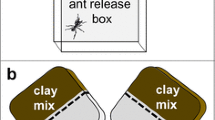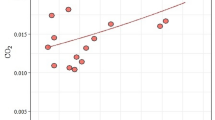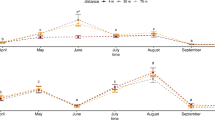Abstract
Ants build underground nests to protect their colonies and to improve conditions for their offspring. The excavation of nests, by ants, modifies the soil structure, facilitating gas exchange and circulation, which needs further studies. Do initial nests modify the initial chamber soil matrix and gas exchange? The objective was to study the soil micromorphology of the wall of the chamber of initial nests of the leaf-cutting ant A. sexdens and how the CO2 diffuses into the soil matrix. The CO2 concentration in initial four-month-old A. sexdens nests was measured for 24 h using a respirometric system with a gas meter and closed nest holes (obliterated). After this period, they were opened and the CO2 concentration measured again. In addition, 15 cm deep holes were drilled into the ground 15 and 60 cm away from the ant nest hole. The CO2 was measured in these orifices and then they were sealed for 24 h and new ones made after this period. The contents of the nest chambers were removed, after the CO2 measures and the soil micromorphology of the walls of the initial chamber analyzed. The CO2 concentration in the nest chamber was greater than that in the soil at 15 and 60 cm distant from it. The CO2 accumulation did not increase with the obliteration of the nest entrance for 24 h. Coarse material, mainly quartz and charcoal fragments, besides fine material of clay, organic matter and iron oxides composed the soil of the wall of initial nests. The soil porosity in the chamber walls of the initial nests was lower than that of the matrix of the adjacent soil and differed between those of the nests. Initial nests of A. sexdens modifies the soil matrix of their walls, allowing to CO2 exchange between its chamber and adjacent soil.




Similar content being viewed by others
References
Autuori M (1942) Contribuição para o conhecimento da saúva (Atta spp. Hymenoptera Formicidae). II. O sauveiro inicial (Atta sexdens rubropilosa, Forel, 1908). Arq Inst Biol (Sao Paulo) 13:67–86
Bollazzi M, Forti LC, Roces F (2012) Ventilation of the giant nests of Atta leaf-cutting ants: does underground circulating air enter the fungus chambers? Insectes Soc 59:487–498
Bullock P, Fedoroff N, Jongerius A et al (1985) Handbook for soil thin section description. Waine Research
Camargo RS, Forti LC, Fujihara RT, Roces F (2011) Digging effort in leaf-cutting ant queens (Atta sexdens rubropilosa) and its effects on survival and colony growth during the claustral phase. Insectes Soc 58:17–22
Camargo RS, Silva EJ, Forti LC, Matos CAO (2016) Initial development and production of CO2 in colonies of the leaf-cutting ant Atta sexdens during the claustral foundation. Sociobiology 63:720–723
Castro SS, Cooper M (2019) Fundamentos de micromorfologia de Solos. Sociedade Brasileira de Ciência do Solo-SBCS, Viçosa
Cooper M, Vidal-Torrado P (2005) Caracterização morfológica, micromorfológica e físico-hídrica de solos com horizonte B nítico. Rev Bras Ciência do Solo 29:581–595
Cosarinsky MI (2006) Nest micromorphology of the neotropical mound building ants Camponotus punctulatus and Solenopsis sp. Sociobiology 47:329–344
Cosarinsky MI (2021) A review of micromorphological studies of ant and termite’s epigean nests located in neotropical soils of Argentina. J S Am Earth Sci 110:103380
Cosarinsky MI, Roces F (2007) Neighbor leaf-cutting ants and mound-building termites: comparative nest micromorphology. Geoderma 141:224–234
Cosarinsky MI, Roces F (2012) The construction of turrets for nest ventilation in the grass-cutting ant Atta vollenweideri: import and assembly of building materials. J Insect Behav 25:222–241
Cristiano MP, Cardoso DC, Sandoval-Gómez VE, Simões‐Gomes FC (2020) Amoimyrmex Cristiano, Cardoso & Sandoval, gen. nov. (Hymenoptera: Formicidae): a new genus of leaf‐cutting ants revealed by multilocus molecular phylogenetic and morphological analyses. Austral Entomol 59:643–676
Evans DD (1966) Gas movement. In: Black CA (ed) Methods of soil analysis. American Society of Agronomy, Madison, Wis, pp 318–330
Fernandez-Bou AS, Dierick D, Swanson AC et al (2019) The role of the ecosystem engineer, the leaf‐cutter ant Atta cephalotes, on soil CO2 dynamics in a wet tropical rainforest. J Geophys Res Biogeosciences 124:260–273
Fujihara RT, Camargo R, da Forti S LC (2012) Lipid and energy contents in the bodies of queens of Atta sexdens rubropilosa Forel (Hymenoptera, Formicidae): pre-and post-nuptial flight. Rev Bras Entomol 56:73–75
Green WP, Pettry DE, Switzer RE (1999) Structure and hydrology of mounds of the imported fire ants in the southeastern United States. Geoderma 93:1–17
Halboth F, Roces F (2017) The construction of ventilation turrets in Atta vollenweideri leaf-cutting ants: Carbon dioxide levels in the nest tunnels, but not airflow or air humidity, influence turret structure. PLoS ONE 12:e0188162
Halley JD, Burd M, Wells P (2005) Excavation and architecture of Argentine ant nests. Insectes Soc 52:350–356
Hasin S, Ohashi M, Yamada A et al (2014) CO2 efflux from subterranean nests of ant communities in a seasonal tropical forest, T hailand. Ecol Evol 4:3929–3939
Hillel D (1998) Environmental soil physics. Academic Press, San Diego
Humphreys GS (1994) Bioturbation, biofabrics and the biomantle: an example from the Sydney Basin. In: Ringrose-Voase A, Humphreys GS (eds) Micromorphology: studies in management and genesis. Elsevier, Amsterdam, pp 421–436
Kleineidam C, Roces F (2000) Carbon dioxide concentrations and nest ventilation in nests of the leaf-cutting ant Atta vollenweideri. Insectes Soc 47:241–248
Kleineidam C, Ernst R, Roces F (2001) Wind-induced ventilation of the giant nests of the leaf-cutting ant Atta vollenweideri. Naturwissenschaften 88:301–305
Mota TMM, Stefanelli LEP, Camargo RS et al (2021) Biological control in leaf-cutting ants. Atta sexdens. Formicidae, Hymenoptera. using pathogenic fungi.
Murphy CP (1986) Thin section preparation of soils and sediments. AB Academic Pub., Berkhamsted, UK
Silva A, Bacci M Jr, de Siqueira CG et al (2003) Survival of Atta sexdens workers on different food sources. J Insect Physiol 49:307–313
Sousa KKA, Camargo RS, Caldato N et al (2021) Carbon dioxide levels in initial nests of the leaf-cutting ant Atta sexdens (Hymenoptera: Formicidae). Sci Rep 11:20562. https://doi.org/10.1038/s41598-021-00099-8
Withers PC (1978) Models of diffusion-mediated gas exchange in animal burrows. Am Nat 112:1101–1112
Acknowledgements
To the Brazilian institutions “Conselho Nacional de Desenvolvimento Científico e Tecnológico (CNPq)”, “Coordenação de Aperfeiçoamento de Pessoal de Nível Superior (CAPES- Finance Code 001), “Fundação de Amparo à Pesquisa do Estado de Minas Gerais (FAPEMIG)” and “Programa Cooperativo sobre Proteção Florestal (PROTEF) do Instituto de Pesquisas e Estudos Florestais (IPEF)” for financial support. We are also grateful to Dr. Pablo Vidal-Torrado and Mariane Chiapini from the Department of Soil Science, “Luiz de Queiroz” School of Agriculture, University of São Paulo (ESALQ/USP), who analyzed the soil samples and provided the photos of the soil micromorphology of the present study. We thank Dr. Julian Sabatini for reading and correcting the manuscript.
Author information
Authors and Affiliations
Contributions
R.S.C. and L.C.F. conceived the experiment(s), K.K.A.S., R.S.C., N.C., J.A.S. and A.P.F. conducted the experiment(s). All authors analysed the results and wrote the manuscript.
Corresponding author
Ethics declarations
Conflict of interest
The authors declare no competing interests.
Additional information
Publisher’s Note
Springer Nature remains neutral with regard to jurisdictional claims in published maps and institutional affiliations.
Rights and permissions
Springer Nature or its licensor (e.g. a society or other partner) holds exclusive rights to this article under a publishing agreement with the author(s) or other rightsholder(s); author self-archiving of the accepted manuscript version of this article is solely governed by the terms of such publishing agreement and applicable law.
About this article
Cite this article
Sousa, K.K.A., Camargo, R.d., Caldato, N. et al. Soil micromorphology and CO2 exchange in initial Atta sexdens (Hymenoptera: Formicidae) nests. Int J Trop Insect Sci 43, 971–977 (2023). https://doi.org/10.1007/s42690-023-01009-3
Received:
Accepted:
Published:
Issue Date:
DOI: https://doi.org/10.1007/s42690-023-01009-3




